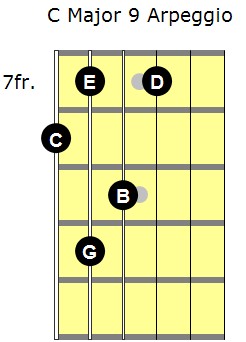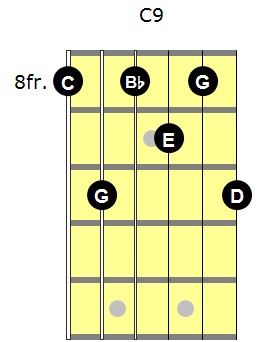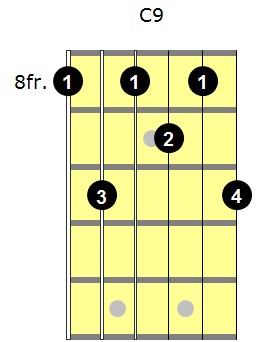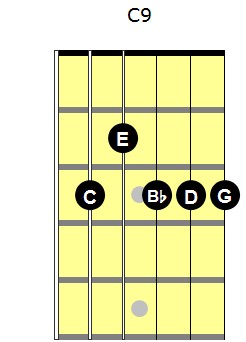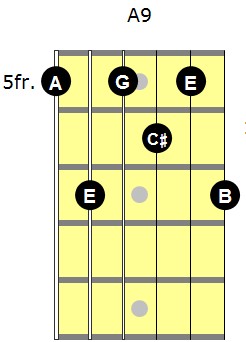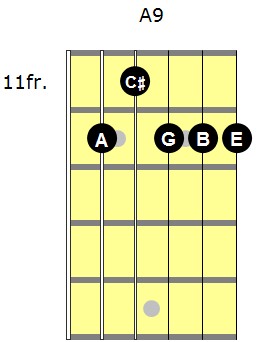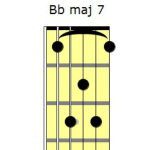Introduction
Dominant 9th chords are common guitar chords found in jazz and blues. Some rock and country styles also make use of these chords. Given their widespread use, it’s important to know how to play them.
In this tutorial, we will look at the basics of how to build dominant 9th chords and play them.
The tough part about learning new chords for most guitar players is remembering how to finger them. The reverse can sometimes be true too—you remember how to play a chord, but have no idea what it is called.
The solution to this, is surprisingly simple: If you know how a chord is built, you can always build your own fingering.
Also, when you understand the basics of chord construction, you can take an existing chord fingering and determine what the chord is actually called.
With this knowledge you will learn guitar chords faster and understand them too!
How to Build a Dominant 9th Chord
Here is how to build a C dominant 9 chord. The C dominant 9 chord is usually abbreviated as C Dom 9, or more commonly just as C9.
We start by looking at the notes found in a two octave C major scale.
| Note: | C | D | E | F | G | A | B | C | D | E | F | G | A | B | C |
| Scale Degree: | 1 | 2 | 3 | 4 | 5 | 6 | 7 | 8 | 9 | 10 | 11 | 12 | 13 | 14 | 15 |
 If we extract the 1, 3, 5, 7 and 9th notes from the C major scale, we get:
If we extract the 1, 3, 5, 7 and 9th notes from the C major scale, we get:
| C | D | E | F | G | A | B | C | D | E | F | G | A | B | C |
| 1 | 3 | 5 | 7 | 9 |
| C MAJ 9 | C | E | G | B | D |
| FORMULA | 1 | 3 | 5 | 7 | 9 |
This is actually a C major 9th chord (commonly abbreviated as C maj 9, or C Maj 9). This chord has a very different sound and function than a C9 chord.
For a dominant 9th chord, we need to lower the 7th scale degree by one semitone (one fret).
| C9 | C | E | G | Bb | D |
| FORMULA | 1 | 3 | 5 | b7 | 9 |
This gives us the following formula:
Dominant 9 Chord: 1 3 5 b7 9
If we apply this formula, we can see that the notes found in a C9 chord are: C-E-G-Bb-D.
So this means if we have the notes: C-E-G-Bb-D, we have a C9 chord.
If we play these notes individually, we will have a C9 arpeggio.
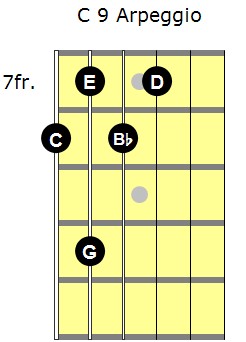 Here are two different ways to play the a C9 chord. The diagrams below show the notes found in the chord and the respective fret-hand fingering.
Here are two different ways to play the a C9 chord. The diagrams below show the notes found in the chord and the respective fret-hand fingering.
You can play any combination of the notes C-E-G-Bb-D and you will have a C9 chord.
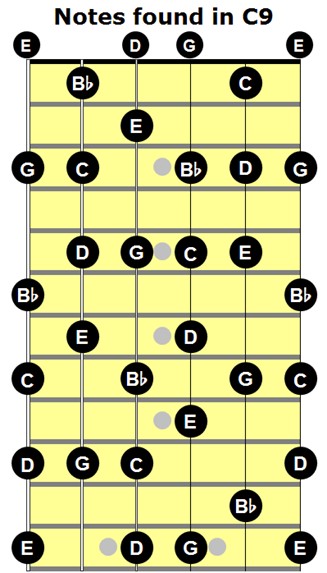 Now let’s look at one more example…
Now let’s look at one more example…
How to Build an A9 Chord
Let’s say you want to build an A9 chord.
To start with, we need the notes in the A major scale.
A major consists of the following notes:
A B C# D E F# G# A
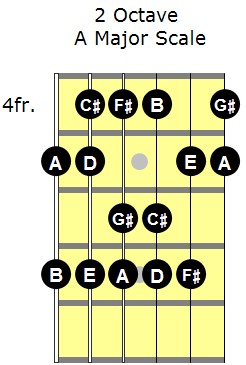 If we write this out as a two octave A major scale and extract the 1-3-5-7-9, we get:
If we write this out as a two octave A major scale and extract the 1-3-5-7-9, we get:
| A | B | C# | D | E | F# | G# | A | B | C# | D | E | F# | G# | A |
| 1 | 3 | 5 | 7 | 9 |
A-C#-E-C#-B
This gives us an A major 9 chord. To build the A9 (A dom 9) chord, we need to lower the 7th by one semitone.
Here is our result:
 When you lower a sharp, it becomes a natural note, so the G sharp becomes a G natural when lowered by one semitone.
When you lower a sharp, it becomes a natural note, so the G sharp becomes a G natural when lowered by one semitone.
So now all we need to do is locate the notes A, C#, E, G, and B on the fretboard and we will have an A9 chord. There are lots of possible ways to play the A9 chord. Here are two:
Did you notice anything about these two fingerings when compared with the C9 fingerings? They are the exact same fingerings! They are just played on different frets. These chords are moveable barre chord fingerings.
Recommended Resource
This short tutorial just covered the basics. There’s lots more to learn about the different types of 9th chords, how to use them and how to play them.
If you ready to learn more about 9th chords and beyond, check out Guitar Essentials: Chord Master Expanded Edition.

